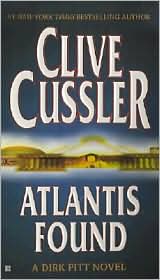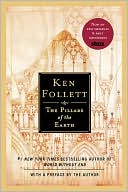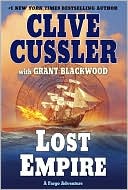Atlantis Found (Dirk Pitt Series #15)
An Antarctic whaler stumbles across an aged wreck—her frozen crew guarding a priceless treasure.\ A team of anthropologists is buried under a mountain by a deliberate explosion.\ A ship that should have died fifty-six years ago reappears, and almost sinks a National Underwater and Marine Agency ship.\ Dirk Pitt knows that somehow these events are connected. His investigations lead to an ancient mystery with devastating modern consequences, and a diabolical enemy unlike any he has ever known....
Search in google:
Dirk Pitt discovers Atlantis, in a breathtaking novel from the grand master of adventure fiction. Clive Cussler has long since proven himself one of America's most popular authors--a master of intricate, audacious plotting and "vibrant, rollicking narrative" (Chicago Tribune). But Atlantis Found may be his most audacious novel of all. September l858: An Antarctic whaler stumbles upon an aged wreck, its grisly frozen crew guarding crates of odd antiquities--and a skull carved from black obsidian. March 200l: A team of anthropologists gazes in awe at a wall of strange inscriptions, moments before a blast seals them deep within the Colorado rock. April 200l: A research ship manned by Dirk Pitt and members of the U.S. National Underwater and Marine Agency is set upon and nearly sunk by an impossibility--a vessel that should have died fifty-six years before. Pitt knows that somehow all these incidents are connected, and his investigations soon land him deep into an ancient mystery with very modern consequences, up against a diabolical enemy unlike any he has ever known, and racing to save not only his own life but the future of the world itself. The trap is set. The clock is ticking. And only one man stands between earth and Armageddon. . . . Filled with dazzling suspense and astonishing set pieces, this is Clive Cussler's greatest adventure novel yet. "I've always had tremendous fun with Dirk Pitt, but nothing has given me more pleasure than the opportunity to send him to that most fabled of lost lands, Atlantis, and to virtually reinvent aspects of its civilization. I hope you have as good a time reading Atlantis Found as I did writing it!"—Clive Cussler Publishers WeeklyDirk Pitt, Cussler's larger-than-life hero, butts heads with an army of elite killers seeking to destroy the world in another wickedly engrossing yet predictably scripted tale of bravery against all odds. As the story begins, artifacts from a previously undiscovered civilization, ancient but highly advanced, are popping up all over the globe. Pitt himself is on site in a Colorado mine when archeologists come across strange carvings and mysterious inscriptions. But then an explosion traps the party below ground, and a band of black-suited terrorists arrive at the scene with guns blazing. Though Pitt saves the day, the incident points toward a wider network of evil schemes. Working for the National Underwater & Marine Agency, Pitt finally identifies the terrorists as members of the Fourth Empire, an organization headed by the diabolical Wolf family, a secret clan of genetically engineered people who worship the Nazi Third Reich. But it's only after Pitt and his able sidekick, Al Giordino, battle old German U-boats, dodge surface-to-air missiles and narrowly escape death on a remote island off Australia that they find out what the Fourth Empire is up to. The neo-Nazis aim to prevent the world from discovering the artifacts of this previously unknown seafaring culture because they tell of a catastrophic event that wiped out civilization 9000 years ago and reveal when the next cataclysm will hit. The Wolfs plan to accelerate the date through their own scheme to destroy Earth, meanwhile sheltering themselves and their thousands of followers on enormous, disaster-proof ships. Pitt knows his assignment: save the world--a tall order, but one he's filled many times before. Cussler's 15th Pitt adventure (after Flood Tide) is a rampaging story of history, technology and heroism, written with Cussler's typical make-no-apologies enthusiasm. For muscle-flexing, flag-waving, belief-suspending fare, he has no equal. Copyright 1999 Cahners Business Information.
Excerpt from Atlantis Found by Clive Cussler\ Impact\ 7120 B.C. What is now Hudson Bay, Canada\ The intruder came from beyond. A nebulous celestial body as old as the universe itself, it had been born in a vast cloud of ice, rocks, dust, and gas when the outer planets of the solar system were formed 4.6 billion years ago. Soon after its scattered particles had frozen into a solid mass one mile in diameter, it began streaking silently through the emptiness of space on an orbital voyage that carried it around a distant sun and halfway to the nearest stars again, a journey lasting many thousands of years from start to finish.\ The comet's core, or nucleus, was a conglomeration of frozen water, carbon monoxide, methane gas, and jagged blocks of metallic rocks. It might accurately be described as a dirty snowball hurled through space by the hand of God. But as it whirled past the sun and swung around on its return path beyond the outer reaches of the solar system, the solar radiation reacted with its nucleus and a metamorphosis took place. The ugly duckling soon became a thing of beauty.\ As it began to absorb the sun's heat and ultraviolet light, a long comma formed that slowly grew into an enormous luminous blue tail that curved and stretched out behind the nucleus for a distance of 90 million miles. A shorter, white dust tail more than one million miles wide also materialized and curled out on the sides of the larger tail like the fins of a fish.\ Each time the comet passed the sun, it lost more of its ice and its nucleus diminished. Eventually, in another 200 million years, it would lose all its ice and break up into a cloud of dust and become a series of small meteorites. This comet, however, would never orbit outside the solar system or pass around the sun again. It would not be allowed a slow, cold death far out in the blackness of space. Within a few short minutes, its life would be snuffed out. But on this, its latest orbit, the comet passed within 900,000 miles of Jupiter, whose great gravitational force veered it off on a collision course with the third planet from the sun, a planet its inhabitants called Earth.\ Plunging into Earth's atmosphere at 130,000 miles an hour on a forty-five-degree angle, its speed ever-increasing with the gravitational pull, the comet created a brilliant luminescent bow shock as its ten-mile-wide, four-billion-ton mass began to break into fragments due to friction from its great speed. Seven seconds later, the misshapen comet, having become a blinding fireball, smashed onto Earth's surface with horrendous effect. The immediate result from the explosive release of kinetic energy upon impact was to gouge out a massive cavity twice the size of the island of Hawaii as it vaporized and displaced a gigantic volume of water and soil.\ The entire earth staggered from the seismic shock of a 12.0 earthquake. Millions of tons of water, sediment, and debris burst upward, thrown through the hole in the atmosphere above the impact site and into the stratosphere, along with a great spray of pulverized, fiery rock that was ejected into suborbital trajectories before raining back to earth as blazing meteorites. Firestorms destroyed forests throughout the world. Volcanoes that had been dormant for thousands of years suddenly erupted, sending oceans of molten lava spreading over millions of square miles, blanketing the ground a thousand or more feet deep. So much smoke and debris were hurled into the atmosphere and later blown into every corner of the land by terrible winds that they blocked out the sun for nearly a year, sending temperatures plunging below freezing, and shrouding Earth in darkness. Climatic change in every corner of the world came with incredible suddenness. Temperatures at vast ice fields and northern glaciers rose until they reached between ninety and a hundred degrees Fahrenheit, causing a rapid meltdown. Animals accustomed to tropical and temperate zones became extinct overnight. Many, such as the woolly mammoths, turned to ice where they stood in the warmth of summer, grasses and flowers still undigested in their stomachs. Trees, along with their leaves and fruit, were quick-frozen. For days, fish that were hurled upward from the impact fell from the blackened skies.\ Waves five to ten miles in height were thrown against the continents, surging over shorelines with a destructive power that was awesome in magnitude. Water swept over low coastal plains and swept hundreds of miles inland, destroying everything in its path. Endless quantities of debris and sediment from the ocean floors were spread over low landmasses. Only when the great surge smashed against the base of mountains did it curl under and begin a slow retreat, but not before changing the course of rivers, filling land basins with seas where none existed before and turning large lakes into deserts.\ The chain reaction seemed endless.\ With a low rumble that grew to the roar of continuous thunder, the mountains began to sway like palm trees under a light breeze as avalanches swept down their sides. Deserts and grassy plains undulated as the onslaught from the oceans reared up and struck inland again. The shock from the comet's impact had caused a sudden and massive displacement in Earth's thin crust. The outer shell, less than forty miles thick, and the mantle that lay over the hot fluid core buckled and twisted, shifting crustal layers like the skin of a grapefruit that had been surgically removed and then neatly replaced so it could move around the core of fruit inside. As if controlled by an unseen hand, the entire crust then moved as a unit.\ Entire continents were shoved around to new locations. Hills were thrust up to become mountains. Islands throughout the Pacific Ocean vanished, while others emerged for the first time. Antarctica, previously west of Chile, slid over two thousand miles to the south, where it was quickly buried under growing sheets of ice. The vast ice pack that once floated in the Indian Ocean west of Australia now found itself in a temperate zone and rapidly began to melt. The same occurred with the former North Pole, which had spread throughout northern Canada. The new pole soon began to produce a thick ice mass in the middle of what once had been open ocean.\ The destruction was relentless. The convulsions and holocaust went on as if they would never stop. The movement of the Earth's thin outer shell piled cataclysm upon cataclysm. The abrupt melting of the former ice packs, combined with glaciers covering the continents that had suddenly shifted into or near tropical zones, caused the seas to rise four hundred feet, drowning the already destroyed land that had been overwhelmed by tidal waves from the comet's impact. In the time span of a single day, Britain, connected to the rest of the European continent by a dry plain, was now an island, while a desert that became known as the Persian Gulf was abruptly inundated. The Nile River, having flowed into a vast fertile valley and then on toward the great ocean to the west, now ended at what had suddenly become the Mediterranean Sea.\ The last great ice age had ended in the geological blink of an eye.\ The dramatic change in the oceans and their circulation around the world also caused the poles to shift, drastically disturbing the earth's rotational balance. Earth's axis was temporarily thrown off by two degrees, as the North and South Poles were displaced to new geographical locations, altering the centrifugal acceleration around the outer surface of the sphere. Because they were fluid, the seas adapted before the earth made another three revolutions. But the landmass could not react as quickly.\ Earthquakes went on for months.\ Savage storms with brutal winds swirled around the earth, shredding and disintegrating everything that stood on the ground for the next eighteen years before the poles stopped wobbling and settled into their new rotational axis. In time, sea levels stabilized, permitting new shorelines to form as bizarre climatic conditions continued to moderate. Changes became permanent. The time sequence between night and day changed as the number of days in a year decreased by two. The earth's magnetic field was also affected and moved northwest over a hundred miles.\ Hundreds, perhaps thousands, of different species of animals and fish became instantly extinct. In the Americas, the one-humped camel, the mammoth, an ice age horse, and the giant sloth all disappeared. Gone also were the saber-toothed tiger, huge birds with twenty-five-foot wingspans and many other animals that weighed a hundred or more pounds, most dying by asphyxiation from the smoke and volcanic gases.\ Nor did the vegetation on land escape the apocalypse. Plant life not turned to ashes by the holocaust died for lack of sunlight, along with the algae in the seas. In the end, over 85 percent of all life on Earth would die from floods, fires, storms, avalanches, poison from the atmosphere, and eventual starvation.\ Human societies, many quite advanced, and a myriad of emerging cultures on the threshold of a progressive golden age were annihilated in a single horrendous day and night. Millions of Earth's men, women, and children died horribly. All vestiges of emerging civilizations were gone, and the few pathetic survivors were left with nothing but dim memories of the past. The coffin had been closed on the greatest uninterrupted advance of mankind, a ten-thousand-year journey from the simple Cro-Magnon man to kings, architects, stonemasons, artists, and warriors. Their works and their mortal remains were buried deep beneath new seas, leaving few physical examples and fragments of an ancient advanced culture. Entire nations and cities that had stood only a few hours before vanished without a trace. The cataclysm of such magnitude left almost no evidence of any prior transcendent civilizations.\ Of the shockingly low number of humans who survived, almost all lived in the higher altitudes of mountain ranges and were able to hide in caves to escape the furies of the turbulence. Unlike the more advanced Bronze Age peoples who tended to cluster and build on low-lying plains near rivers and ocean shorelines, the inhabitants of the mountains were Stone Age nomads. It was as though the cream of the crop, the Leonardo da Vincis, the Picassos, and the Einsteins of their era had evaporated into nothingness, abruptly leaving the world to be taken over by primitive nomadic hunters, a phenomenon similar to what happened to the glory of Greece and Rome after it was cast aside in favor of centuries of ignorance and creative lethargy. A neolithic dark age shrouded the grave of the highly cultured civilizations that once existed in the world, a dark age that would last for two thousand years. Slowly, very slowly, did mankind finally walk from the dark and begin building and creating cities and civilizations again in Mesopotamia and Egypt.\ Pitifully few of the gifted builders and creative thinkers of the lost cultures survived to reach high ground. Realizing their civilization was lost, never to rise again, they began a centuries-long quest to erect the mysterious megaliths and dolmens of huge upright stones found across Europe, Asia, the Pacific Islands, and into the lower Americas. Long after the memory of their shining legacy had dimmed and become little more than myth, their monuments commemorating the frightful destruction and loss of life still acted as warnings of the next cataclysm to future generations. But within a millennium, their descendants slowly forgot the old ways and assimilated with the nomadic tribes and ceased to exist as a race of advanced people.\ For hundreds of years after the convulsion, humans were afraid to venture down from the mountains and reinhabit the lower lands and coastal shorelines. The technically superior seafaring nations were but vague thoughts of a distant past. Ship construction and sailing techniques were lost and had to be reinvented by later generations whose more accomplished ancestors were revered simply as gods.\ All this death and devastation was caused by a hunk of dirty ice no larger than a small farm town in Iowa. The comet had wreaked its unholy havoc, mercilessly, viciously. The earth had not been ravaged with such vehemence since a meteor had struck 65 million years earlier in a catastrophe that had exterminated the dinosaurs.\ For thousands of years after the impact, comets were associated with superstitions of catastrophic events and considered omens of future tragedies. They were blamed for everything from wars and pestilence to death and destruction. Not until recent history were comets considered nature's wonders, like the splendor of a rainbow or clouds painted gold by a setting sun.\ The biblical flood and a host of other calamity legends all had ties to this one tragedy. The ancient civilizations of Olmecs, Mayans, and Aztecs of Central America had many traditions relating to an ancient cataclysmic event. The Indian tribes throughout the United States passed down stories of waters flooding over their lands. The Chinese, the Polynesians, and Africans all spoke of a cataclysm that decimated their ancestors.\ But the legend that was spawned and that flourished throughout the centuries, the one that provoked the most mystery and intrigue, was that of the lost continent and civilization of Atlantis.
\ From Barnes & NobleHow does an author maintain a successful career for more than a quarter century? By making each book better than the one before. Dubbed the grandmaster of adventure fiction by fans and critics alike, Clive Cussler continues to produce action-packed thrillers unlike anyone writing today. Rightly, he is the benchmark by which other genre novels are measured; to say that he's done it again with his latest blockbuster, Atlantis Found, would be a gross understatement. Whether raising the Titanic or foiling the schemes of countless villains, Dirk Pitt, Cussler's hero of 15 previous bestsellers, has become a legend to millions of readers. And who but Pitt could go after the greatest legend of them all -- Atlantis. As in his previous books, Cussler's Atlantis Found has a plot that's impossible to top, action that is bloody and frequent, and stakes as high as they can be. The cliched "roller coaster" analogy that we reviewers often tag a thriller just doesn't do this novel justice since Cussler's latest accelerates the whole way through. \ With his typical sardonic wit and the aid of his NUMA (National Underwater and Marine Agency) coworkers, Dirk Pitt faces the biggest challenge of his life. It starts for Pitt during an exploratory dive in an abandoned Colorado mine that turns into the daring rescue of archeologist Patricia O'Connell -- daring not only because the mine is about to collapse, but also because there are killers in the subterranean passages who will stop at nothing to ensure that O'Connell's discovery of some ancient runes is not made public. From this white-knuckle episode the story evolves into the twin search to understand the writing's message and uncover the identity of the killers.\ In order to learn the meaning of the ancient writing, Pitt must first duel with an antique submarine in frigid southern waters, discover the secret behind a massive landlocked shipyard in the Argentine fjords, and travel to a tiny island between Africa and Australia where another piece of the puzzle has lain hidden for 10,000 years. Only when he learns the truth behind these mysteries does Pitt discover that the answers may also be the death knell of civilzation. If that's not enough to keep your eyes glued to the pages, there's also a powerful industrialist with neo-Nazi ties whose machinations aim to make him and his family rulers of a truly new World Order. Hurtling toward a literal earth-shattering climax on the Antartic coast, it again becomes clear that the fate of billions rests on Pitt's shoulders. And the final twist? Well, it's something I've rarely seen in a thriller; it will leave long-time fans of Dirk Pitt gasping.\ As in any great epic, Pitt's new quest involves a number of labors, both physical and mental, where each answer reveals more questions. With a seamless blend of discovery and adventure, this is where Cussler shines -- catapulting readers from scene to scene. His imaginative set pieces are among the best in fiction. If you want globetrotting action with a heavy dose of humor, then Atlantis Found is Cussler -- and Pitt -- at their very best.\ And now my excruciating wait to see how Cussler's going to top this begins.\ --Jack Du Brul\ \ \ \ \ \ Publishers Weekly - Publisher's Weekly\ Dirk Pitt, Cussler's larger-than-life hero, butts heads with an army of elite killers seeking to destroy the world in another wickedly engrossing yet predictably scripted tale of bravery against all odds. As the story begins, artifacts from a previously undiscovered civilization, ancient but highly advanced, are popping up all over the globe. Pitt himself is on site in a Colorado mine when archeologists come across strange carvings and mysterious inscriptions. But then an explosion traps the party below ground, and a band of black-suited terrorists arrive at the scene with guns blazing. Though Pitt saves the day, the incident points toward a wider network of evil schemes. Working for the National Underwater & Marine Agency, Pitt finally identifies the terrorists as members of the Fourth Empire, an organization headed by the diabolical Wolf family, a secret clan of genetically engineered people who worship the Nazi Third Reich. But it's only after Pitt and his able sidekick, Al Giordino, battle old German U-boats, dodge surface-to-air missiles and narrowly escape death on a remote island off Australia that they find out what the Fourth Empire is up to. The neo-Nazis aim to prevent the world from discovering the artifacts of this previously unknown seafaring culture because they tell of a catastrophic event that wiped out civilization 9000 years ago and reveal when the next cataclysm will hit. The Wolfs plan to accelerate the date through their own scheme to destroy Earth, meanwhile sheltering themselves and their thousands of followers on enormous, disaster-proof ships. Pitt knows his assignment: save the world--a tall order, but one he's filled many times before. Cussler's 15th Pitt adventure (after Flood Tide) is a rampaging story of history, technology and heroism, written with Cussler's typical make-no-apologies enthusiasm. For muscle-flexing, flag-waving, belief-suspending fare, he has no equal. Copyright 1999 Cahners Business Information.\ \ \ Library JournalA highly advanced civilization is destroyed by a comet . An ancient British ship is found frozen in Antarctica . A Nazi submarine prowls beneath the seas . If all of this sounds a bit fantastic, it's just another sign of a Cussler novel featuring his Bond-ish hero, Dirk Pitt, who has previously raised the Titanic and found the body of Abraham Lincoln in the middle of the Sahara Desert; saving the world is all in a day's work. Following the discovery of a strange obsidian skull that seems to have geographic markings on it that represent Earth's continents in strange locations, Pitt and his companions find themselves tracking down the strangest mystery in history: Was Atlantis real or a fable? The answer is hinted at in the title, but even with the discovery of the secret to the ancient civilization, Pitt's travails are just beginning. He must locate and destroy a family that traces its roots back to the dark days of Hitler and who have known for years that the world is about to come to an end, based on predictions by the highly advanced civilization. Will Dirk and the rest of the NUMA crew be able to prevent this disaster? Michael Prichard has read Pitt books before and gives them the right mix of incredulity, humor, and suspense. Cussler knows how to tell a compelling tale, and his work is always in demand. This will be a highly popular title for all public libraries.--Joseph L. Carlson, Lompac P.L., CA Copyright 2000 Cahners Business Information.\\\ \ \ \ \ School Library JournalYA-Once again, Cussler sends his superhero Dirk Pitt into the thickest of plots, against the odds and against human and natural forces that most mere mortals would never survive. Ancient archaeological sites are found containing relics of the advanced civilization identified as Atlantis, including a completely baffling written language. When finally deciphered, the inscriptions contain a prediction of the world's end in the next few months. At the same time, in South America, the Wolf family and its enterprises are assembling a massive clandestine operation. And, on Antarctica, a seemingly innocent scientific- research site proves to be a diabolical setup for destroying the known world. However, Dirk Pitt and his friend and partner, Al Giordino, destroy the dastardly plan. Offering one action-packed scene after another, Cussler guarantees to keep the pages turning at a rapid rate. There are plenty of technologically advanced gadgets and machines, along with secretive movements to add a thriller quality to the plot. Cussler writes himself into the story as a minor player in the mayhem, poking fun at his own writing. This book provides plenty of adventure, as well as top-rate entertainment.-Pam Johnson, Fairfax County Public Library, VA Copyright 2000 Cahners Business Information.\|\ \








